Czechoslovak post-war anti-aircraft installations
The troops had 7,92 mm machine guns equipped with anti-aircraft sights: German MG-34 and MG-42 and Czech ZB-26, ZB-30, ZB-53, captured from the Germans and remaining in the warehouses of the Zbrojovka Brno enterprise. In addition, the infantry units operated Soviet 7,62-mm SG-43 machine guns on the Degtyarev wheeled machine, which made it possible to fire at air targets. The 12,7-mm DShK machine gun became the air defense means of the battalion link. Air strike protection by infantry and tank regiments were provided with batteries of German captured 20-mm rapid-fire artillery installations: 2,0 cm Flak 28, 2,0 cm FlaK 30 and 2,0 cm Flak 38, as well as Soviet 37-mm machine guns 61-K. It is reliably known that the protection of Czechoslovak airfields from low-altitude bombing and assault strikes until the second half of the 1950s was provided by the quad 20-mm 2,0 cm Flakvierling 38 mounts. In anti-aircraft artillery brigades and regiments formed to cover strategically important objects, Soviet 85-mm guns got along with the German 88-mm anti-aircraft guns. Machine guns of 7,92-mm and 20-mm machine guns were sent to warehouses in the mid-1950s, and 88-mm anti-aircraft guns remained in service until the early 1960s.
12,7 mm anti-aircraft guns
Already in the late 1940s in Czechoslovakia, which had a developed armory industry and highly qualified personnel, began to create their own anti-aircraft weapons systems. Soon after the end of hostilities, the designers of Zbrojovka Brno, based on the experience gained during the years of German occupation, created the ZK.477 heavy machine gun. In parallel with the ZK 477 tests, a 12,7-mm Vz.38 / 46 machine gun was launched into production, which was a licensed version of the Soviet DShKM. Externally, the modernized machine gun was distinguished not only by a different form of muzzle brake, the design of which was changed in the DShK, but also by the silhouette of the receiver cover, in which the drum mechanism was canceled - it was replaced by a two-way power receiver. The new power mechanism allowed the use of a machine gun in twin and quad installations. Since the development of ZK.477 took time, and it did not have cardinal advantages over the DShKM, work on it was curtailed.
As you know, Czech companies made a very significant contribution to equipping the Wehrmacht and the SS armored vehicles. In particular, the Czech factories produced half-track armored Sd.kfz. 251 (better known in our country by the name of the manufacturer of the company "Ganomag"). After the war, this armored personnel carrier was produced in Czechoslovakia under the designation Tatra OT-810. The car differed from its German prototype by a new diesel engine of air cooling manufactured by Tatra, a fully enclosed armored case and an improved undercarriage.
In addition to armored personnel carriers intended for the transportation of infantry, specialized modifications were produced: carriers of various weapons and tractors. On a part of the machines on a special pedestal, which allowed circular fire, they installed large-caliber machine guns Vz.38 / 46, thus obtaining an improvised self-propelled anti-aircraft gun.
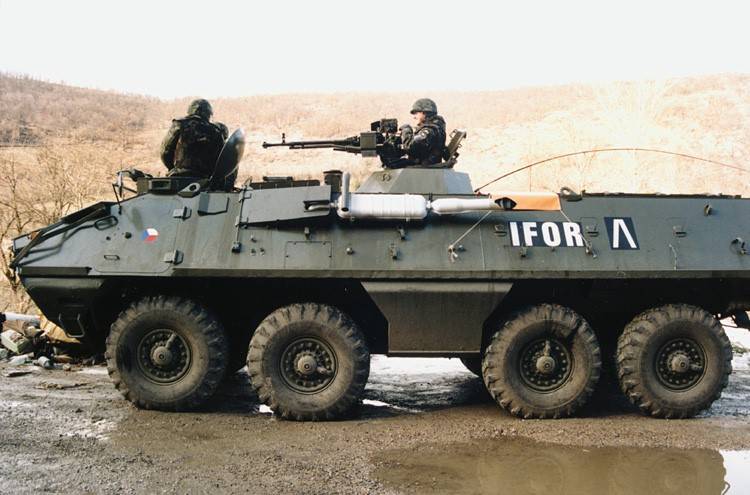
Later, a similar-purpose vehicle with a turret 12,7-mm machine gun was created on the chassis of the wheeled armored personnel carrier OT-64. In 1970-1980-s such armored personnel carriers in the armed forces of Czechoslovakia were used to transport calculations of the Strela-2M MANPADS. In the middle of the 1990-ies, an armored personnel carrier with large-caliber machine gun turrets served as part of the Czech peacekeeping contingent in the territory of the former Yugoslavia.
One of the first models adopted by the Czechoslovak army in the postwar period, was the quad 12,7-mm installation Vz.53. ZPU had a detachable wheel course and weighed in the combat position 558 kg. Four 12,7 mm barrels per second were fired up to 60 bullets. The effective range of fire on air targets is about 1500 m. In range and height reach, the Czechoslovak Vz.53 was inferior to the Soviet quad 14,5-mm ZPU-4. But Vz.53 was much more compact and weighed in the transport position about three times less. She could be towed by an all-wheel drive GAZ-69, or in the back of a truck.
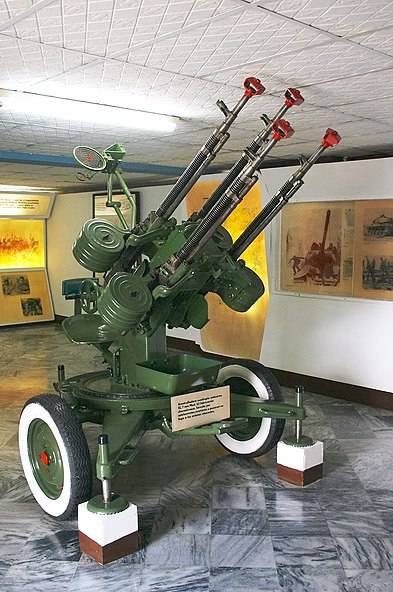
ZPU Czechoslovak production Vz.53 in the exposition of the Cuban museum, dedicated to the events at Playa Chiron
In the second half of 1950's, ZPU Vz.53 was tested in the USSR and earned high marks. The Czechoslovak 12,7-mm quad installation in the 1950-1960-ies was actively exported and participated in many local conflicts. For its time, it was a quite effective weapon, capable of successfully fighting low-altitude air targets.
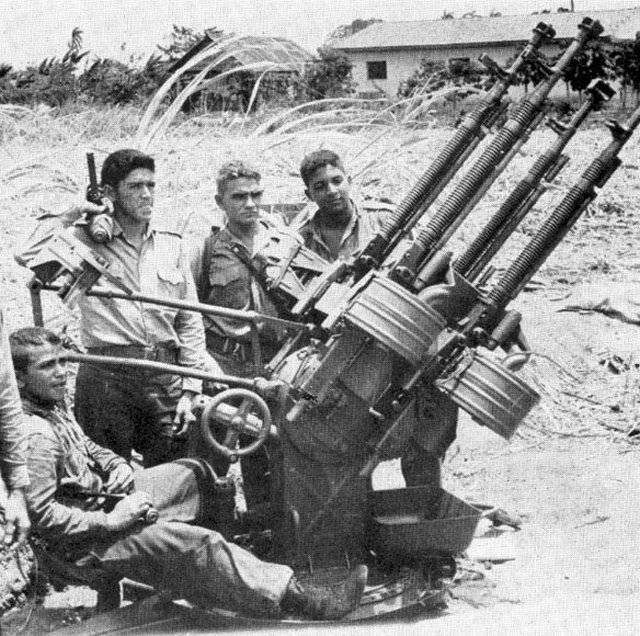
In a reflection of the landing of anti-Castro forces on Playa-Chiron in April 1961, Cuban ZPU Vz.53 calculations shot down and damaged several Douglas A-26В Invader bombers. Czechoslovak quad machine guns were also used in the Arab-Israeli wars, and some of them were captured by the Israeli army.
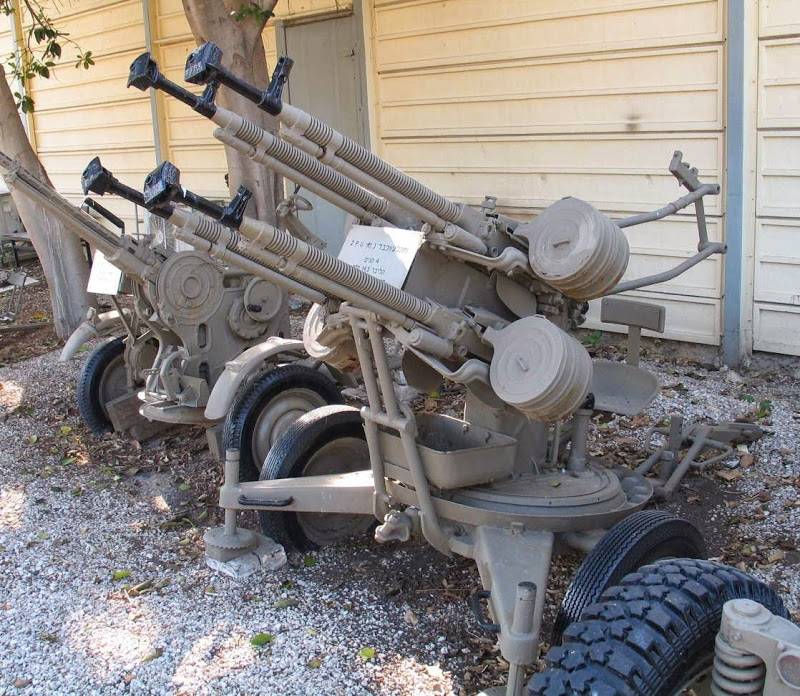
In the Czechoslovak armed forces, the quadruple 12,7-mm anti-aircraft installations Vz.53 were used in the air defense battalion and regimental link until the middle of the 1970-x, until Strela-2М was deployed.
30-mm anti-aircraft installations
As you know, during the Second World War, Czech factories were a real forge of weapons for the German army. Simultaneously with the production, the Czechs created new types of weapons. Based on the Kriegsmarine commissioned by the engineers of the Zbrojovka Brno twinned 30-mm 3,0 installation with Flakzwilling MK 303 (Br), the towed double-barreled M1950 anti-aircraft gun, also known as the 53-mm anti-aircraft kit, was created at the beginning of the 30-x. 453
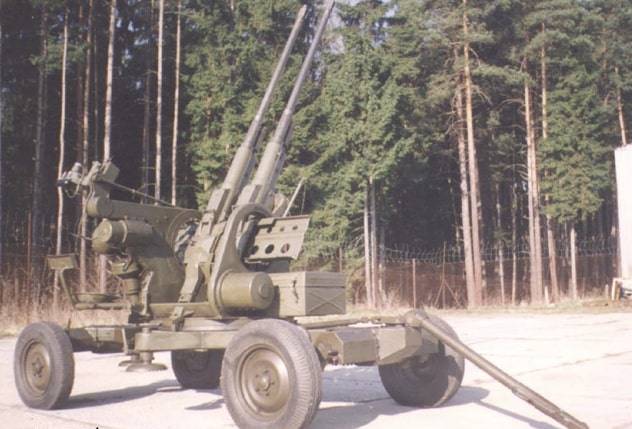
The automatics gas engine provided a rate of fire of up to 500 rpm per barrel. But since the anti-aircraft gun was powered from hard cassettes on 10 shells, the real combat rate did not exceed 100 rounds / min. The ammunition consisted of armor-piercing, incendiary tracer and high-explosive fragmentation projectiles. An armor-piercing incendiary tracer of mass 540 g with an initial speed of 1 000 m / s at a distance of 500 m could penetrate the steel armor along the normal 55 mm. High-explosive fragmentation projectile with a mass of 450 g left the barrel with a length of 2363 mm with an initial speed of 1 000 m / s. The firing range of the airborne targets was up to 3000. The artillery part of the installation was mounted on a four-wheel vehicle. At the firing position she was posted on jacks. Weight in the traveling position 2100 kg, in combat 1750 kg. Calculation - 5 people.
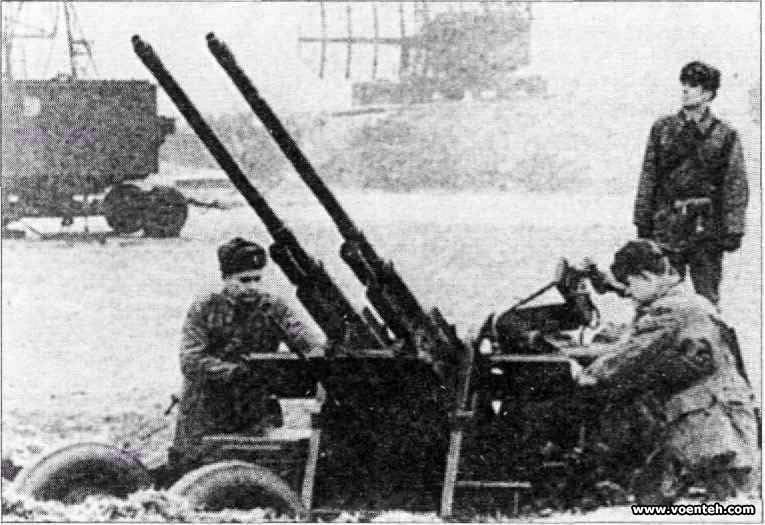
ZK.453 towed anti-aircraft guns were reduced to batteries using 6 guns, but if necessary they could be used individually. The main disadvantage of ZK.453, as well as the Soviet ZU-23, is its limited capacity in conditions of poor visibility and at night. It did not mate with a radar fire control system and did not have a centralized station in the battery.
Comparing ZK.453 with Soviet-made 23-mm ZU-23, it can be noted that the Czechoslovak installation was heavier and had a lower combat rate of fire, but the effective shelling zone was about 25% higher and its projectile had a greater destructive effect. 30-mm twin installations ZK.453 were used in the military air defense of Czechoslovakia, Yugoslavia, Romania, Cuba, Guinea and Vietnam. In most countries, they have already been decommissioned.
The twin towed 30-mm ZK.453 units had low mobility and relatively low combat rate of fire, which did not allow them to be used for anti-aircraft cover of transport convoys, motorized rifle and tank units. In order to eliminate these shortcomings, the Praga PLDvK VZ self-propelled anti-aircraft gun was used in the 1959 year. 53 / 59, received in the army the unofficial name "Jesterka" - "Lizard". Wheel ZSU mass 10300 kg had a good cross and could accelerate on the highway to 65 km / h. Cruising on the highway 500 km. Crew 5 man.
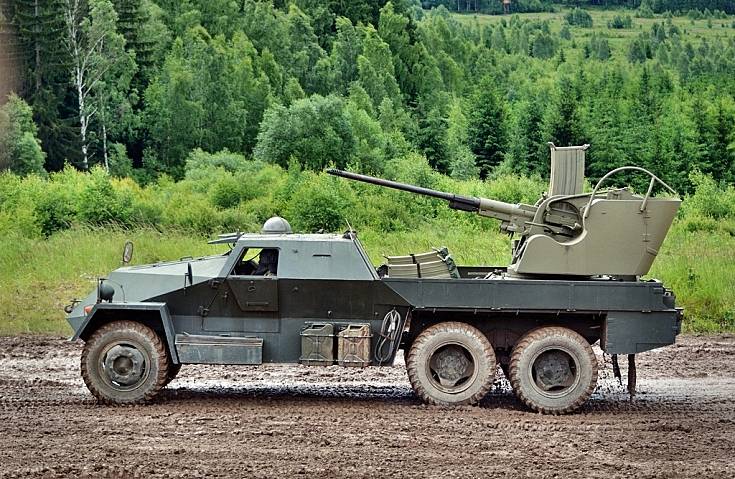
The base for the ZSU was the Praga V3S three-wheel-drive truck. At the same time, ZSU received a new armored cabin. The armor provided protection against rifle caliber small arms and light splinters. Compared to ZK.453, the artillery part of the self-propelled unit was changed. To increase the combat rate of fire, 30-mm anti-aircraft guns were transferred to box-type stores with a capacity of 50 shots.
The rate of pickup of the twin 30-mm anti-aircraft gun was improved by the use of electric drives. As a backup, manual guidance was used. In the horizontal plane there was the possibility of a circular attack, the angles of vertical guidance from -10 ° to + 85 °. In case of emergency it was possible to fire on the move. Fighting rate: 120-150 rds / min. The rate of fire and ballistic characteristics remained at the level of installation ZK.453. The total ammunition in 8 stores was 400 shots. With the weight of one equipped 84,5 kg store, replacing them for two infecting ones was not an easy procedure and required considerable physical effort.
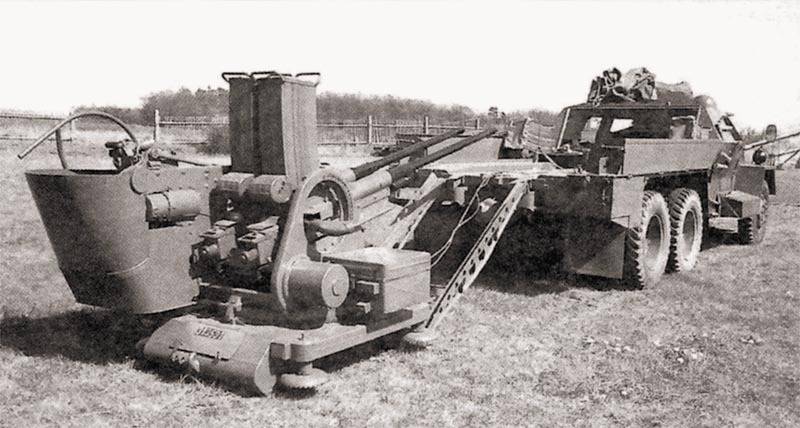
Artillery installation with the help of special guides, cables and a winch could be transferred to the ground, and used permanently in the prepared positions. This expanded tactical capabilities, and facilitated the masking of an anti-aircraft battery during defensive operations.
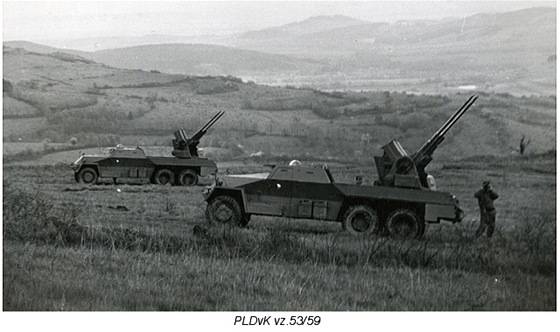
Due to the simplicity, reliability and good operational and combat qualities ZSU PLDvK VZ. 53 / 59 was popular with the troops. Until the middle of the 1970-ies, the Czechoslovak self-propelled "Lizards" were considered quite modern means of air defense and under the designation М53 / 59 were popular on the world arms market. Their buyers were: Egypt, Iraq, Libya, Cuba, Yugoslavia and Zaire. Most of all M53 / 59 was delivered to Yugoslavia. According to Western data, by 1991, 789 ZSU was supplied to the Yugoslav army.
The M53 / 59 self-propelled anti-aircraft guns were used by the warring parties in the course of the armed conflicts that broke out in the territory of the former Yugoslavia. Initially, the Serbian army used the 30-mm ZSU for firing at ground targets. Due to the considerable density of fire and high initial speed of 30 millimeter shells that pierced through the brick walls of houses, and the ability to fire on the upper floors and attics, anti-aircraft guns became indispensable in urban battles.
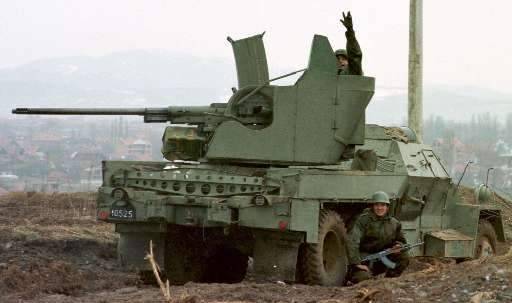
These anti-aircraft installations were particularly active during the hostilities in Bosnia and Kosovo. After the first combat clashes, the characteristic sound of their firing had a strong psychological effect on the enemy soldiers: invulnerable to small-arms fire, the M53 / 59 easily dealt with uncovered infantry and lightly armored vehicles.
In the middle of 1990-x ZSU М53 / 59 were considered hopelessly obsolete, and Western military analysts did not take them seriously when planning air strikes on Serbia. In the course of the reflection of the bombing of Serbia and Montenegro by NATO forces in 1999, the ZNU M53 / 59 engaged in air defense. The NATO air forces actively used electronic warfare, making it difficult to use radar stations. But the M53 / 59 did not have centralized control systems with radar detection. Therefore, the EW funds against them were useless, and a well-prepared calculation could effectively destroy low-flying air targets, detecting them visually. According to official Serbian data, 53 cruise missiles and one drone were hit by ZNS М59 / 12. The only manned aircraft shot down by 24 June 1992 of the year was the Croatian MiG-21.
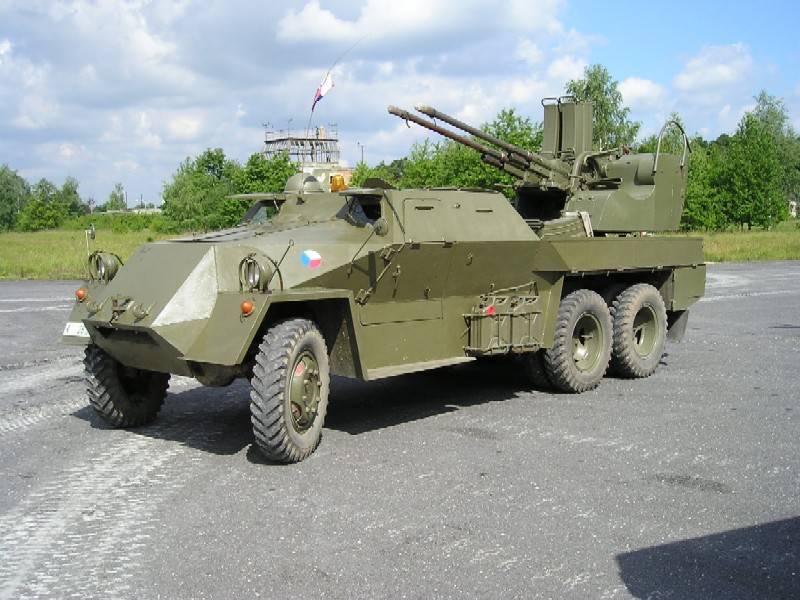
In the Czech Republic, the latest ZSU PLDvK VZ. 53/59 were withdrawn from service in 2003. In Slovakia, there are still approximately 40 self-propelled guns in storage. Also, wheeled ZSUs were preserved in the armed forces of Bosnia and Herzegovina and in Serbia. In Yugoslavia and Czechoslovakia, in the late 1980s, attempts were made to create short-range air defense systems based on anti-aircraft self-propelled guns equipped with missiles with a thermal homing head: K-13, R-60 and R-73.
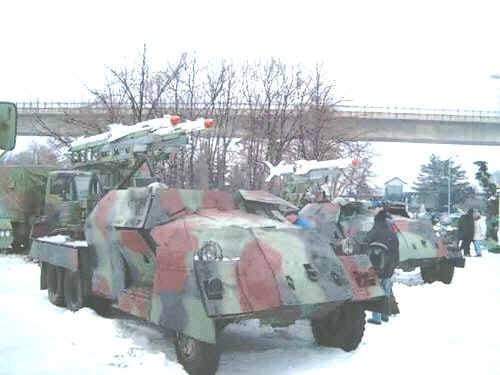
To increase the flight speed of the missiles at launch, they had to be equipped with additional accelerating solid-propellant boosters. After testing, the serial construction of improvised self-propelled anti-aircraft missile systems in Czechoslovakia was abandoned. In Yugoslavia, 12 air defense systems were built with the PL-4M missiles - modified R-73E air-to-air missiles. As additional upper stages, engines from aviation NAR C-24. Theoretically, the PL-4M missile defense system could hit a target at a distance of 5 km, an altitude reach of 3 km. In 1999, four PL-4Ms were launched at night at real targets in the vicinity of Belgrade. Whether it was possible to achieve a hit is unknown. One launcher was located on the territory of Kosovo, where two A-10 Thunderbolt II attack aircraft were fired from it during daylight hours. The pilots of American aircraft timely noticed the launch of the missile defense system and avoided defeat by using heat traps.
Wheel ZSU PLDvK VZ. The 53 / 59 was well suited to escort traffic convoys and anti-aircraft cover of objects in the rear. But because of the weak booking and the lack of cross-country ability, they could not move in the same battle formations with tanks. In the middle of 1980-x in Czechoslovakia was created ZSU BVP-1 STROP-1. The base for it was the tracked infantry fighting vehicle BVP-1, which was the Czechoslovak version of the BMP-1. According to the requirements of the military, the car was equipped with an optoelectronic search and aiming system, a laser rangefinder, and an electronic ballistic computer.
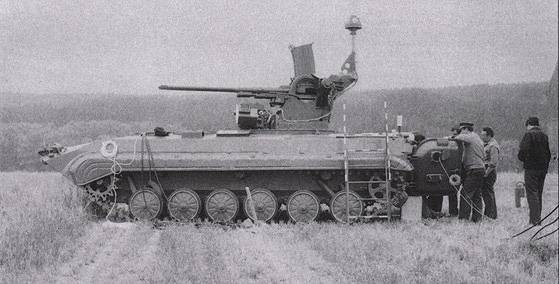
During the tests carried out in 1984, during daylight it was possible to detect the MiG-21 fighter at a distance of 10-12 km and determine the distance to it with high accuracy. At the ZVU BVP-1 STROP-1, a remote-controlled artillery unit from PLDvK VZ was used. 53 / 59. The firing range was 4 km. Effective range 2000 m.
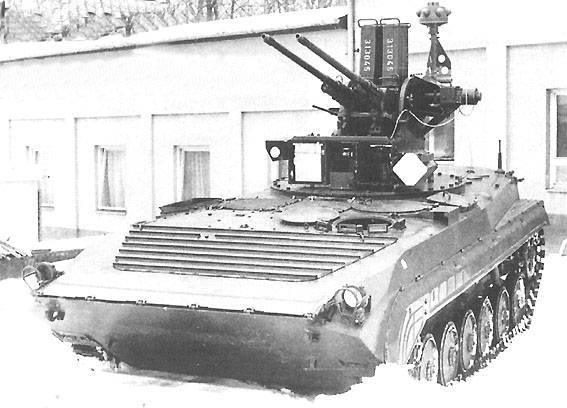
Thus, the Czechs tried to cross the latest electronics with anti-aircraft guns, which were descended from the 30-mm guns used by the Germans during World War II. It is worth recalling that in the USSR from the 1965 of the year, the ZSU-23-4 Shilka with a detection radar arrived in the army, and in 1982, the Soviet Army received the Tunguska anti-aircraft missile system. The use of anti-aircraft artillery guns with external box-loading at that time was an anachronism, and quite predictably, the BVP-1 STROP-I ZSU did not adopt it.
In 1987, work began on the STROP-II anti-aircraft missile and artillery system. The car was armed with a Soviet 30-mm 2A38 cannon turret (used as part of the Tunguska and Pantsir-S1 armament) and missiles with a Strela-2M missile. The 7,62-mm PKT machine gun was also paired with guns.
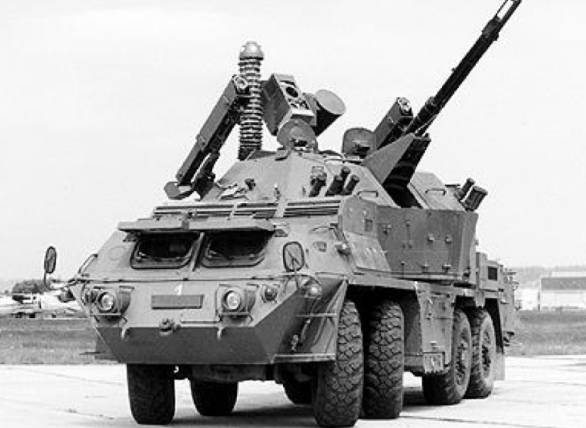
The basis for the STROP-II ZRPK was a wheel easily armored platform known as Tatra 815 VP 31 29 with a wheel formula 8х8. The same chassis was used when creating the 152-mm ACS VZ. 77 Dana. The fire control system was the same as on the STROP-I ZSU. However, during the tests that began in 1989, it turned out that the drive of the horizontal guidance of the massive tower gives an unacceptable error, which affects the accuracy of shooting. In addition, the choice of Strela-2M missiles was due to the fact that this MANPADS was produced under license in Czechoslovakia. But by the end of 1980-x, this complex with uncooled IR GOS no longer met the requirements for modern air defense systems. In the existing form of ZRPK STROP-II, the military did not suit. The future of the mobile complex was influenced by the “Velvet Revolution” and the breakdown of military-technical cooperation with Russia.
After the divorce from the Czech Republic was presented the Slovak version - ZRPK BRAMS. The chassis and the artillery part remained the same, but the fire control system and control equipment were re-created. The radar of the machine did not appear, for the search for targets and guidance it was supposed to use an optoelectronic system consisting of a television camera with powerful optics, a thermal imager and a laser rangefinder - providing acceptable range for detection equipment and tracking of airborne targets. In addition, instead of two frankly outdated Strela-2М missiles in the rear part of the tower, Igla-1 twin missiles were placed on the sides of the globe with sensors of the guidance system. In order to ensure stability, when firing, the machine is fixed by four hydraulic supports.
The BRAMS ZRPK is capable of hitting targets with cannon fire at a distance of up to 4000 m, anti-aircraft missiles - up to 5000 m. Angles of vertical pickup of weapons: from -5 ° to + 85 °. The car weighing 27100 kg accelerates on the highway to 100 km / h. Power reserve 700 km. Crew 4 man.
In the 1990-2000-ies, the armed forces of Slovakia, due to financial constraints, could not afford to purchase new anti-aircraft missile systems. In this regard, BRAMS ZRPK was offered for export only. The car was repeatedly demonstrated at weapon shows, but was not interested in potential buyers. Simultaneously with the Slovaks, the Czechs tried to breathe new life into the anti-aircraft complex based on the Tatra 815 chassis. Instead of a turret with a 30-mm 2A38 cannon and MANPADS, the new STYX self-propelled self-propelled gun was to receive a paired 35-mm Swiss-made Oerlikon GDF-005 artillery. However, things did not go further than the layouts.
57-mm anti-aircraft guns
During World War II, it turned out that for antiaircraft artillery there was a “difficult” altitude range from 1500 m to 3000. Here the planes were not very accessible for small-caliber anti-aircraft guns, and for heavy anti-aircraft artillery guns, this height was too small. To solve the problem, it seemed natural to create anti-aircraft guns of some intermediate caliber. The German concern Rheinmetall AG has released a small batch of 50-mm anti-aircraft 5-cm Flak 41. But, as they say, the gun "did not go", when operating in the army, revealed major shortcomings. Despite the relatively large caliber, 50-mm shells did not have enough power. In addition, the flashes of shots even on a sunny day blinded the gunner. The carriage in real combat conditions was too cumbersome and inconvenient. The horizontal guidance mechanism was too weak and worked slowly. In March, 1944 of the year, Skoda’s Czech designers were tasked with creating a new 30-mm automatic anti-aircraft gun on the basis of the 3,0-mm 303 installation with the Flakzwilling MK 50 (Br) artillery unit. According to the set TTZ, the new 50-mm anti-aircraft gun should have a range of fire - 8000 m, initial velocity of the projectile - 1000 m / s, mass of the projectile - 2,5 kg. Later, the caliber of this gun was increased to 55 mm, which was supposed to increase the range, reach and destructive power of the projectile.
After the war, work on creating a new anti-aircraft gun continued, but now it was designed for the caliber 57-mm. In 1950, several prototypes were presented for testing, differing in the power supply system and carriages. The first prototype of the gun under the symbol R8 had a platform with four folding beds and a removable wheelbase. The R8 anti-aircraft gun weighed nearly three tons. Power 57-mm anti-aircraft guns carried out from a metal tape. The second R10 prototype, which had a similar projectile feeding system, was mounted on a carriage designed like an 40-mm anti-aircraft Bofors L / 60 anti-aircraft gun, so it weighed a ton more. A third prototype of the R12 was also installed on a two-axle wheeled cart, but the shells were delivered from the 40-charging magazine, which increased its weight compared to the R10 on the 550 kg. After the tests, requirements were made to increase the horizontal range of shooting to 13500 meters, and the ceiling had to be at least 5500 meters. Also, the military noted the need to improve the reliability and build quality of the guns, as well as increasing the pick-up speed. The trunk survivability resource should have been at least 2000 shots. The platform of the gun was supposed to be removable, and the calculation of the gun was to have a shield cover protecting from rifle rifle bullets and shrapnel. The total mass of anti-aircraft guns with a platform should not exceed four tons.
The revision of the 57-mm anti-aircraft gun was delayed, and after unsuccessful military tests in 1954, the question arose of stopping further refinement. By that time, the USSR successfully produced a fairly successful 57-mm anti-aircraft gun C-60 and the prospects for the Czechoslovak anti-aircraft gun, which also had unique unitary shots that were not interchangeable with the Soviet 57-mm projectiles were foggy. But the leadership of Czechoslovakia, after the elimination of major defects, in order to support its own arms industry in 1956, initiated the serial production of the R10 guns, which were adopted under the designation VZ.7S. Anti-aircraft 57-mm guns entered the 73-th artillery anti-aircraft regiment in Pilsen, and in the 253-th and 254-th anti-aircraft regiments of the 82-th anti-aircraft artillery division in Jaromir.
Automation tools worked by the removal of powder gases and a short stroke of the barrel. Food was carried out from a metal tape. For targeting the electric drive powered from the petrol generator was used. The ammunition consisted of unitary shots with fragmentation tracer and armor-piercing shells. The mass of the projectile was 2,5 kg, the initial speed - 1005 m / s. Rate of Fire - 180 rds / min. The mass of the gun in the combat position - about 4200 kg. Calculation - 6 people. Travel speed - up to 50 km / h.
Comparing the 57-mm anti-aircraft guns of Czechoslovak and Soviet production, it can be noted that the VZ.7S slightly exceeded the C-60 in the initial velocity of the projectile, which gave a greater direct shot range. Thanks to the tape power system, the Czechoslovak anti-aircraft gun was faster. At the same time, the Soviet anti-aircraft gun C-60 showed better reliability and cost significantly less. From the very beginning, the C-60 battery consisted of a gun-laying station, which ensured greater efficiency of anti-aircraft fire. As a result, the entire ZNILX guns VZ.219S were assembled at ZVIL Pilsen, which were used in parallel with the Soviet C-7 before the 1990s began.
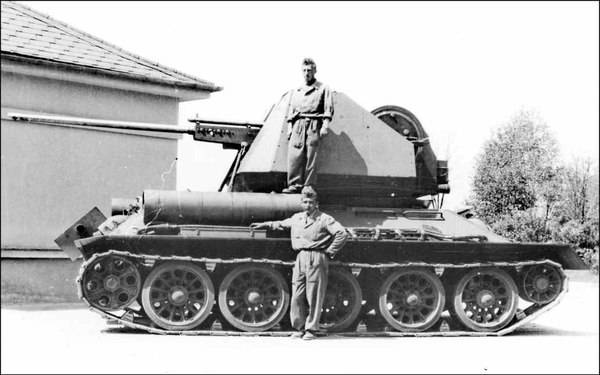
Simultaneously with the development of the towed 57-mm anti-aircraft gun R10, its self-propelled version was created in Czechoslovakia. As the chassis used tank T-34-85. From 1953 to 1955, a few ZSU modifications were made. But in the end, the Czechs preferred the Soviet paired ZSU-57-2 based on the T-54 tank, which were in service until the second half of the 1980-x.
Medium-caliber anti-aircraft guns
At the end of 1940 in Czechoslovakia, there were up to a hundred and fifty medium-caliber anti-aircraft guns: 85-mm anti-aircraft guns of the X-NUMX model 12 of the year XS and 1944-mm 88-cm Flak 8,8 cm. However, based on the experience of using German anti-aircraft artillery against Allied bombers, Škoda engineers in 37 started designing 8,8-mm anti-aircraft guns with an increased initial velocity of the projectile and increased rate of fire. The new artillery system, which received the factory designation R41, had much in common with the German 1948 anti-aircraft gun cm Flak 100. From the German guns took the carriage, barrel design, sliding mechanisms and a number of other details. To increase the combat rate of fire, store food was used, which allowed making 11 shots / min. Impressive for such a caliber rate of fire combined with excellent ballistic characteristics. With a barrel length of 8,8 mm (41 gauges), the initial velocity of the projectile was 25 m / s. The gun R5500 exceeded the COP-55, which had a barrel length 1050 calibers. So 11-mm anti-aircraft gun KS-19 could launch 60 projectiles per minute, with an initial speed of 100 m / s.
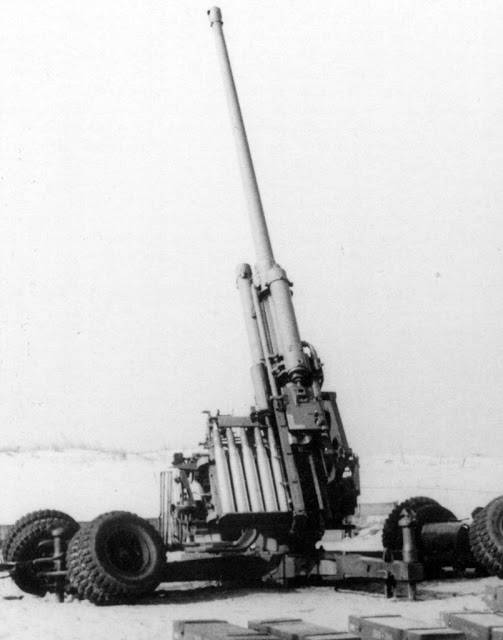
Despite the superiority in a number of parameters over the Soviet KS-19 anti-aircraft gun, it was not possible to bring the Czechoslovak 100-mm R11 anti-aircraft gun to mass production. And it was not only that on the tests the prototype of the gun gave a lot of failures and demanded a lot of work. Surely, Skoda specialists would be able to cope with major technical problems and tighten the artillery system to the required level of operational reliability. After the establishment of the communist regime in Czechoslovakia, the new leadership of the country for the sake of political and economic dividends decided to curtail a number of ambitious programs to create a number of samples of armored vehicles and artillery, orienting to Soviet-made heavy weapons and equipment. As a result, Czechoslovakia received several dozen 100-mm anti-aircraft guns KS-19М2, which were operated until the beginning of the 1980-s, after which they were deposited.
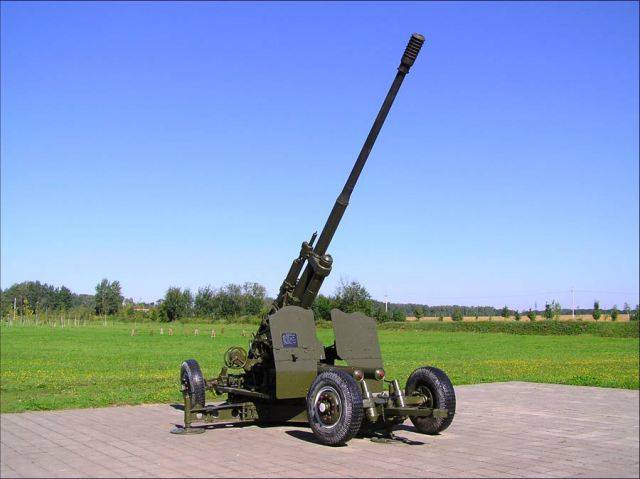
Unlike 85-mm anti-aircraft guns obr.1944, at which the data for the shooting were issued with outdated PUAZO-4A, COP-19M2 control by anti-aircraft battery system carried GSP-100M designed for automatic remote aiming in azimuth and elevation, or eight less guns and automatic entry of values for the installation of the fuse according to the radar station antiaircraft guidance. Tool homing was carried out centrally, with the help of servo hydraulic drives.
In addition to the already mentioned 85-, 88- and 100-mm anti-aircraft guns of Soviet and German production, 130-mm anti-aircraft guns KS-30 were supplied to Czechoslovakia for arming anti-aircraft artillery regiments.
With a mass in the combat position 23500 kg, the gun fired 33,4 kg with fragmentation shells leaving the barrel with an initial velocity 970 m / s. The firing range of the aerial target was up to 19500. The 130-mm anti-aircraft gun had a separate sleeve loading, with a combat rate of fire of up to 12 rds / min. The guns in the anti-aircraft battery were built automatically using servo drives, according to data from the anti-aircraft fire control device. The response time of remote fuses was also automatically set. Target parameters were determined using the gun station SON-30.
Compared to the KS-19 anti-aircraft guns, issued in the number of 10151 copies, the 130-mm KS-30 released a lot less - 738 guns. Czechoslovakia was one of the few countries (besides the USSR) where the KS-30 anti-aircraft guns were in service. Currently, all 130-mm anti-aircraft guns are decommissioned. Several copies are kept in Czech museums.
To be continued ...
- Linnik Sergey
- Czechoslovakia. Constructions that are not inferior to the best world analogues
Czechoslovakia. Post-war fighter aircraft
Saab JAS-39 Gripen versus MiG-29: rejection of the socialist legacy for NATO integration
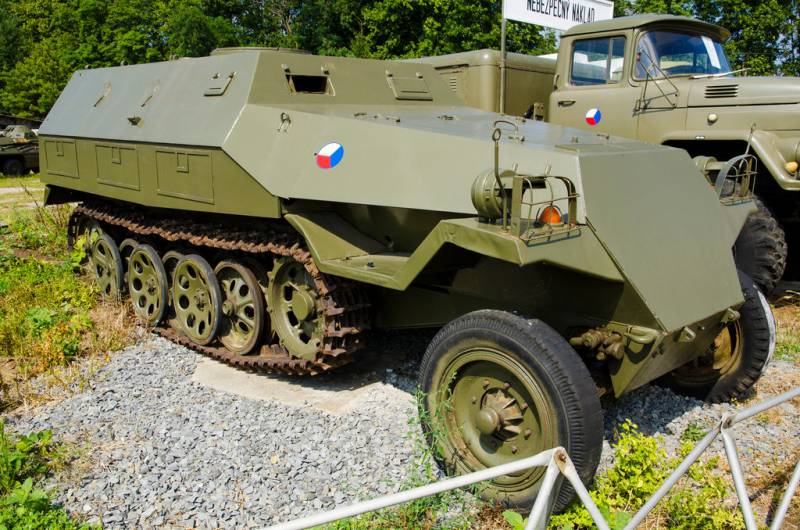
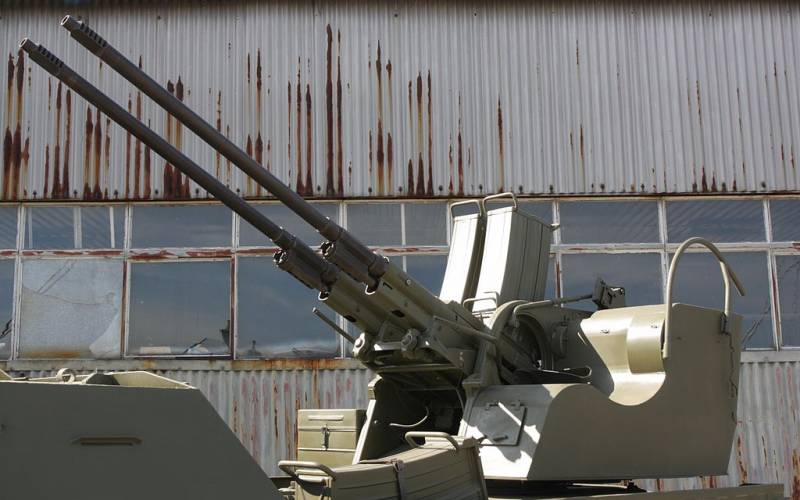
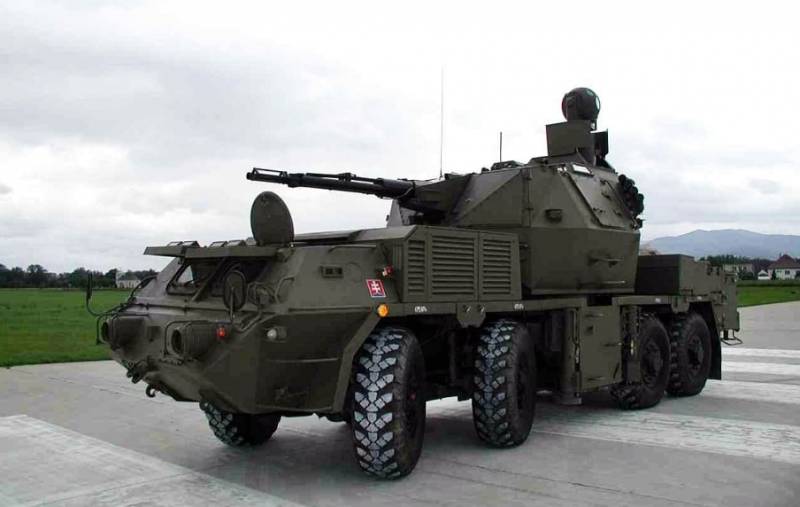
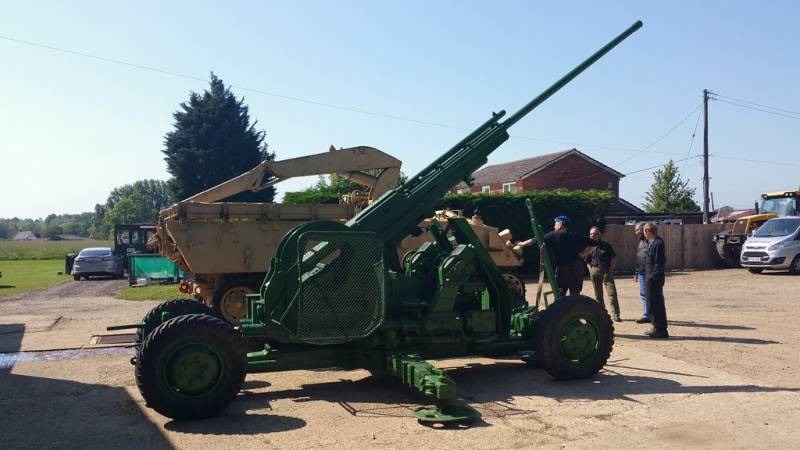
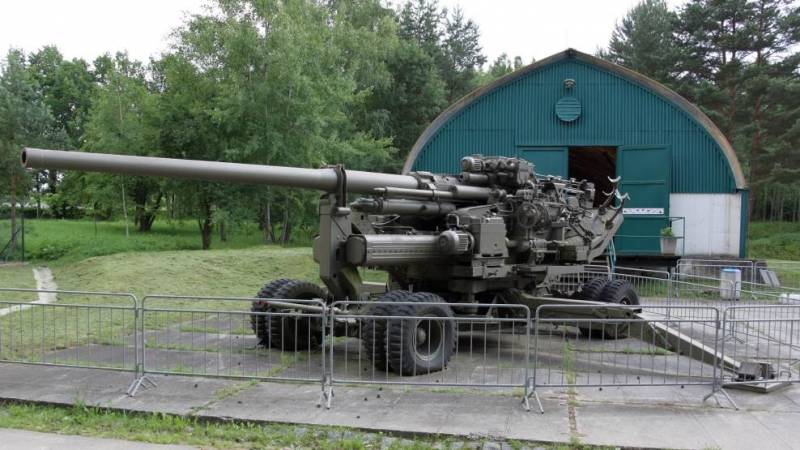
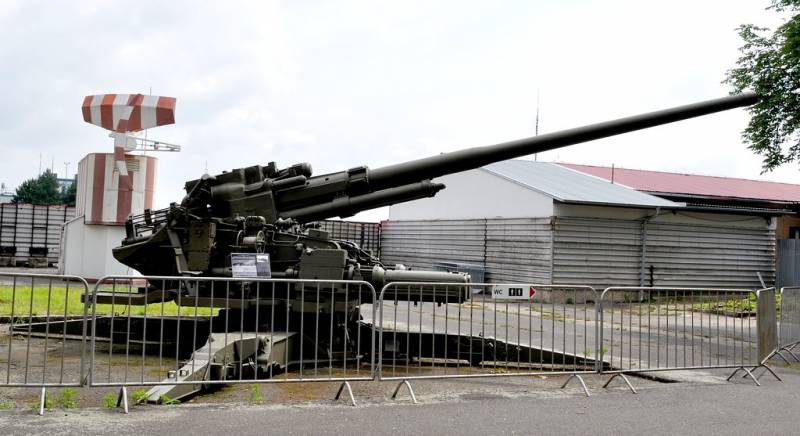
Information